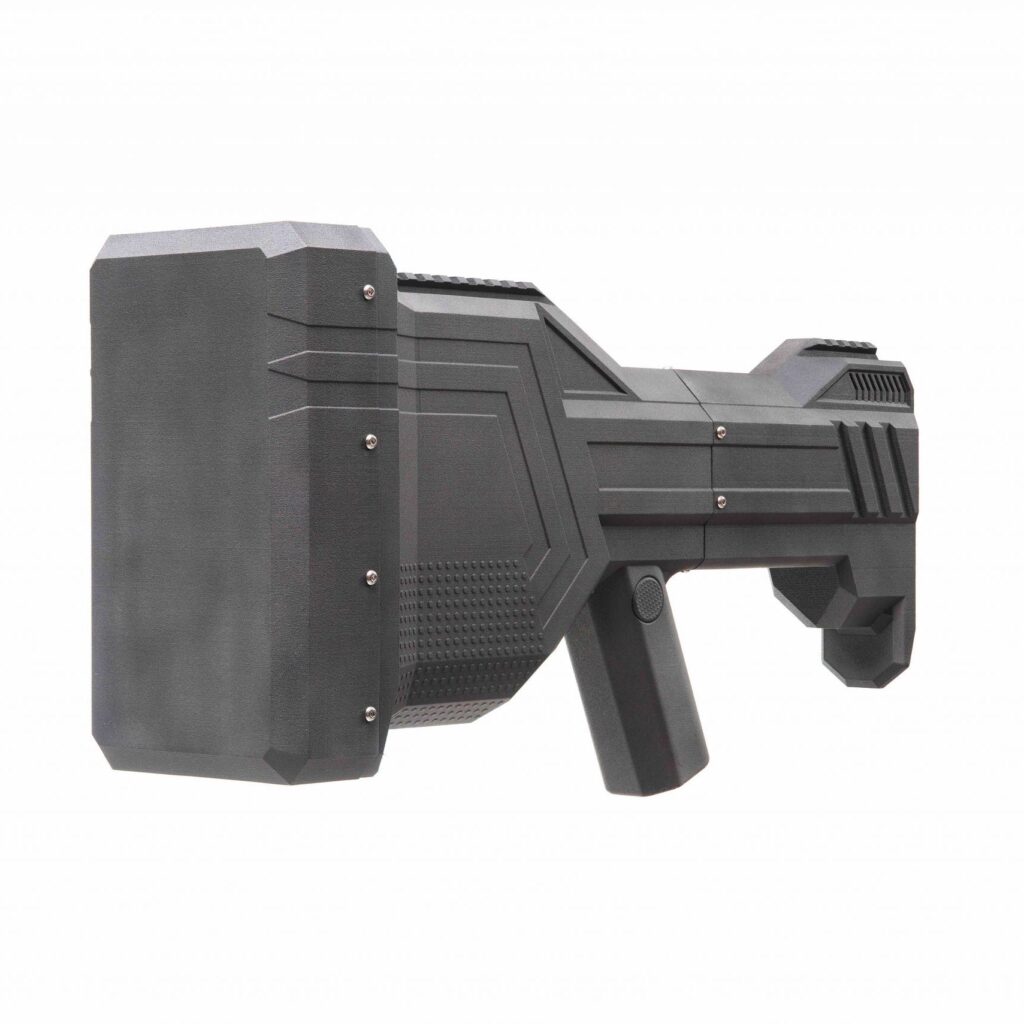While the general public is concerned with the creation of 3D printed guns by petty criminals, arms manufacturers are turning to additive manufacturing (AM) for the production of advanced weaponry. British defense company London Defense R&D has unveiled “the world’s first” 3D printed tactical anti-drone system.

London Defense R&D Founder Aytekin Güçlü with the LD-80. Image courtesy of LinkedIn.
The LD-80 is said to be made using Multi Jet Fusion (MJF) technology from HP, one of the primary methods for large run polymer 3D printing on the market. The weapon is described as having a range of 1,000 meters, meant to take down unmanned aerial vehicles (UAVs) using an electronic attack to disrupt their control and command frequencies and force them into emergency landing mode.
London Defense Founder Aytekin Güçlü told 3DPrint.com that the device has already been tested:
“In the early months of the war, we sent one of our first products to Ukraine. It was tested by the Ukrainian army and achieved excellent results. LD-80 is a product that operates with its specially designed antenna and all internal electronic systems. We have put a lot of effort into ensuring the lossless transmission of high-powered electromagnetic energy through the 3D printed casing.”
As a result of the firm’s antenna technology, it has been able to obtain a registration from the United Kingdom Intellectual Property Office. Moreover, London Defense claims that “the LD80 can shoot down more than 30 drones on a single charge.” The antenna is said to enable this long range capability and compact and lightweight design, enabled with 3D printing.
Güçlü said, “The product has significant advantages over its competitors in terms of size and weight. Of course, the fantastic cost advantages of producing with 3D printing technology makes us much more economical than our competitors. We are happy because we have proven that a tactical product can be manufactured using 3D layered manufacturing technology and can be used in real conditions.”
Interestingly, the company is advertising the sale of the weapon’s design itself, noting the following: “LD-80 represents a paradigm shift in the defense industry, empowering individuals and organizations to produce their own tactical products. Instead of purchasing the finished product, users can now access the design at a significantly reduced cost, democratizing access to advanced defense capabilities.” Güçlü elaborated on this concept:
“Our initial idea was to share the design with our customers and have them produce LD-80 casings in their own countries. They would only need to source the battery, electronics, and antenna from us. The high engineering invested in the product allows even the simplest technician to easily assemble it.”
London Defense R&D suggests that the system could be 3D printed anywhere at any time, though true distributed manufacturing has yet to really be achieved due to issues related to the ability to ensure the same quality and repeatability with multiple facilities in different locations. However, because this device is produced in part with HP’s technology, it is more realistic to envision such a scenario. Regardless, the marketing impact of 3D printing these weapons using an MJF system anywhere is not lost here, with a company like London Defense surely able to convince decision-makers of the company’s role in supply chain resilience.

The 3D printed LD-80. Image courtesy of London Defense R&D.
Needless to say, the ability to 3D print anti-drone devices “anywhere” is a risky prospect. One might imagine, say, the British armed forces acquiring the designs and appropriate antenna hardware, etc. in order to manufacture and assemble the LD-80 near a conflict. At the same time, without rigorous security procedures, it’s possible that any enemy force could do the same.
As 3DPrint.com Executive Editor Joris Peels has pointed out, drone warfare may represent a testbed for the experimental use of 3D printing in rapid weapons manufacturing. In war zones like Ukraine, there have been numerous reports of 3D printed drones and other systems deployed by both sides, so it’s very possible that anti-drone devices like the LD-80 could be born out of the conflict. The ability to rapidly improvise new weapons with 3D printing is a reality, so it may just be a matter of time before something like the LD-80 emerges.
Subscribe to Our Email Newsletter
Stay up-to-date on all the latest news from the 3D printing industry and receive information and offers from third party vendors.
You May Also Like
3D Printing Unpeeled: New Arkema Material for HP, Saddle and Macro MEMS
A new Arkema material for MJF is said to reduce costs per part by up to 25% and have an 85% reusability ratio. HP 3D HR PA 12 S has been...
3D Printing News Briefs, January 20, 2024: FDM, LPBF, Underwater 3D Printer, Racing, & More
We’re starting off with a process certification in today’s 3D Printing News Briefs, and then moving on to research about solute trapping, laser powder bed fusion, and then moving on...
3D Printing Webinar and Event Roundup: December 3, 2023
We’ve got plenty of events and webinars coming up for you this week! Quickparts is having a Manufacturing Roadshow, America Makes is holding a Member Town Hall, Stratafest makes two...
Formnext 2023 Day Three: Slam Dunk
I’m high—high on trade show. I’ve met numerous new faces and reconnected with old friends, creating an absolutely wonderful atmosphere. The excitement is palpable over several emerging developments. The high...































